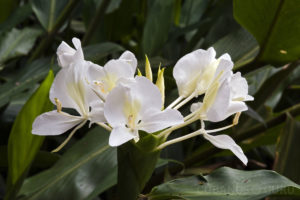In Cuba it is very common since the 19th century in the gardens and patios, and also as a naturalized species in wild places with humid soils a white flower very aromatic, lanceolate leaves envainadoras, commonly known as “butterfly”. For its exquisite perfume is very popular in Cuba where they are used in bridal bouquets, to adorn the altars and in the hair of women, custom that our popular tradition attributes to the peasants who from long ago adorned with “butterfly” their long hair .
It is very abundant in the rainy season, during which its flowering is accompanied by its aromatic and unmistakable perfume. It is of Asian origin, but it proliferates easily in the fields of Cuba, on the banks of rivers and ponds.
On October 13, 1936, it was declared a national symbol of Cuba, due to its links to the independence struggles of the Cuban people. In those days of combat against the Spanish colonial power Cuban women, combatants or sympathizers of the Cuban cause, used the branches of “butterflies” to hide messages destined to the insurgent forces.
But in this time its use as an ornament in the female hair became a symbol of rebellion among Cubans and identification with the fighters for the freedom of Cuba. It became so important its symbolic value that it became necessary to hide it from the sight of the Spanish soldiers because they were an evident sign of “infidence”.
As a patriotic symbol the “butterfly” represents the purity of the ideals of the Cubans and the love for the just peace of those who struggle to obtain independence from their homeland, that’s why that day at an international flower exhibition held in Buenos Aires, the Cubans proclaimed the simple flower of the “butterfly”, its national flower.
“LA MARIPOSA”, LA FLOR NACIONAL CUBANA.
En Cuba es muy común desde el siglo XIX en los jardines y patios, y también como especie naturalizada en lugares silvestres con suelos húmedos una flor de color blanco muy aromático, de hojas lanceoladas envainadoras, conocida vulgarmente como “mariposa”. Por su exquisito perfume es muy popular en Cuba donde se les utiliza en ramos de novia, para adornar los altares y en los cabellos de las mujeres, costumbre que nuestra tradición popular atribuye a las campesinas que desde antaño adornaban con “mariposa” sus largas cabelleras.
Es muy abundante en la época de lluvia, durante la cual su floración va acompañada de su aromático e inconfundible perfume. Es de origen asiático, pero prolifera con facilidad en los campos de Cuba, a las orillas de ríos y estanques.
El 13 de octubre de 1936 fue declarada símbolo nacional de Cuba, por su vinculación a las luchas independentistas del pueblo cubano. En aquellos días de combate contra el poder colonial español las mujeres cubanas, combatientes o simpatizantes de la causa cubana, utilizaban los ramos de “mariposas” para ocultar mensajes con destino a las fuerzas insurrectas.
Pero en esta época su uso como adorno en la cabellera femenina se convirtió en símbolo de rebeldía entre las cubanas y modo de identificación con los combatientes por la libertad de Cuba. Llegó a ser tan importante su valor simbólico que se hizo necesario ocultarla de la vista de los soldados españoles porque eran una muestra evidente de “infidencia”.
Como símbolo patriótico la “mariposa” representa la pureza de los ideales de los cubanos y el amor por la paz justa de los que luchan por obtener la independencia de su patria, por eso ese día en una exposición internacional de flores celebrada en Buenos Aires, los cubanos proclamaron a la sencilla flor de la “mariposa”, su flor nacional.
Agencies/Ramón Guerra/Various/ Internet Photo/ Arnoldo Varona/ TheCubanHistory.com
THE CUBAN HISTORY, HOLLYWOOD.








